- Home
- Tom Clancy
Airborne: A Guided Tour of an Airborne Task Force Page 26
Airborne: A Guided Tour of an Airborne Task Force Read online
Page 26
The first operational tankers (the KB-29, KB-50, and KC-97) were developed from the four-engine Boeing B-29 bomber. By the mid 1950s, though, it was clear that piston-powered tankers did not have the speed to refuel jet-powered bombers and fighters efficiently. The old tankers lacked the speed to keep up with the jets, which had to slow down, nearly to their stall speed, to refuel. The answer was the KC-135 Stratotanker, which closely resembled the four-engined Boeing 707 commercial transport.41 Between 1956 and 1966, some 732 of these aircraft were built specifically as tankers, with dozens of other C-135 airframes completed or modified as transports, flying command posts, intelligence collectors, VIP passenger carriers, and for other specialized roles. About 560 remain in service with the aerial refueling squadrons of the USAF, USAF Reserve, and ANG. Many have been reengined as KC-135Qs and -Ts, with the fuel-efficient CFM-56 turbofan replacing the original noisy, smoky, gas-guzzling J-57 turbojets. With a top speed of 521 kn/966 kph and a fuel payload of 31,200 gallons/118,000 liters, the KC-135 was an excellent tanker. It could fly out 2,000 nm/3700 km and off-load as much as 74,000 lb/33,500 kg of fuel to waiting customers.
The most serious limitation of the Stratotanker emerged during the long-range emergency airlifts to South Vietnam in 1972 and Israel in 1973. During these operations, many U.S. allies refused landing rights to aircraft bound for Israel and Vietnam, fearing economic retaliation (or worse) from various interested powers. This greatly limited the tonnage of cargo that could be rushed to resupply the desperate Israeli and Vietnamese forces, which began the war with only a one- or two-week reserve of ammunition. The problem was that KC-135 could either deploy to a distant overseas base, or refuel other aircraft; it could not do both on the same mission. In particular, the basic KC-135 could not be itself refueled in the air. Truly strategic air refueling and deployment missions would require a tanker of much greater capacity and endurance than the -135.
By the mid-1970s the USAF knew what they needed, and an Air Force program office started the process of developing a new deployment tanker. Known as the Advanced Tanker/Cargo Aircraft (ATCA), it was envisioned by the program managers as an aircraft that could support the overseas deployment of entire tactical fighter squadrons, carrying spares, munitions, ground equipment, and personnel while refueling the squadron’s aircraft on the way. An added requirement was that the ATCA itself had to be able to refuel in flight as well. As planned, a force of only seventeen ATCAs could support the deployment of a complete fighter squadron from the eastern United States to Europe, a mission that would require forty KC-135s, plus additional C-141 cargo aircraft.
In the interests of reducing cost, the natural ATCA choice was a modified version of one of the (then) new wide-body commercial transports. The first of this new generation of jet transports began with the first flight of the four-engined Boeing 747 on February 9th, 1969. Another contender, the Douglas Aircraft Company (part of McDonnell Douglas) in Long Beach, California, entered the wide-body competition in 1970 with a version of their three-engined DC-10. Most of the DC-10’s fuselage length is a perfect cylinder, which made modifying the interior extremely easy. The DC-10 had made its first flight on August 29th, 1970, and an extended-range variant, the DC-10-30, with uprated engines appeared in 1972.
In 1977, McDonnell Douglas successfully entered a tanker version of the DC-10-30 in the ATCA competition, and a contract for sixteen aircraft was awarded. Initially, the production rate was only two per year, but in 1982 the total buy was increased to sixty, allowing Douglas to keep the production line open for years at a more favorable (and profitable) production rate. When it entered service in March 1981, the new aircraft was dubbed the KC-10A Extender. At the time, the KC-10s belonged to the USAF’s Strategic Air Command (SAC). In 1991, however, when SAC was absorbed into the new Air Combat Command (ACC) and Air Mobility Command (AMC), most of the tankers were transferred to AMC. Except for one aircraft destroyed on the ground by a fire, the entire force remains in service with four active and two Reserve squadrons, split between MacGuire AFB, New Jersey, and Travis AFB, California.
It’s important to know that it is not practical to build a tanker that has the entire fuselage filled with fuel tanks. Such an aircraft would be too heavy to take off. The KC-10 carries most of its fuel in seven “bladder” tanks located under the floor of the spacious pressurized cargo compartment. This is the space where passenger baggage and freight would be stowed on a commercial DC-10. Additional fuel is carried in the wings, and all the tanks are interconnected so that the KC-10 can “give away” almost all the fuel it carries, beyond even a minimum safety margin needed to return to base, since the KC-10 can itself be refueled by another tanker sent out to retrieve it. A typical “strategic” refueling mission would be the transfer of 200,000 pounds of fuel at a distance of 2,200 miles/3540 km from a base—for example in the middle of the Atlantic Ocean. In a pure airlift role, the KC-10 can fly almost 7,000 miles/over 11,000 km carrying 100,000 lb/45,400 kg of cargo. With in-flight refueling and a spare flight crew (pilot, copilot, and flight engineer) the KC-10’s range and endurance are practically unlimited, subject only to the need to replenish engine oil. The KC-10’s engines are highly efficient General Electric CF6-50C2 turbofans (military designation F103) each rated at 52,500 pounds (23,810 kg) of thrust. Maximum takeoff weight of the KC-10 is 590,000 lb/267,620 kg, while the empty weight is only about 240,000 lb/109,000 kg.
A McDonnell Douglas KC-10A Extender refueling a C-17A Globemaster III. The fleet of 59 KC- 10s is vital to American forces being able to deploy rapidly overseas.
McDONNELL DOUGLAS
AERONAUTICAL SYSTEMS
Inside the KC-10, the cockpit is about what you would expect of a mid- 1970’s jumbo jet. The electronics suite is relatively simple: a weather radar in the nose, standard UHF and VHF radios, a triple-redundant inertial navigation system supplemented with GPS, and an IFF transponder to tell friendly aircraft, ships, and SAMs not to shoot. No defensive systems (chaff, flares, or ECM jammers) are normally fitted. As a very high-value asset, the KC-10 would normally be escorted by at least a pair of fighters in any environment that presented the slightest threat.
The reason for the KC-10’s existence is to be found at the rear of the aircraft. The refueling boom, measuring 43 feet/13.1 meters when fully extended, has its own digital flight control system, and can deliver up to 1,500 gallons/5,678 liters of fuel per minute. It is normally retracted up against the tail, but still contributes a certain amount of excess drag. Every KC-10 also carries one drogue-and-hose reel unit mounted under the tail, allowing it to refuel the many Navy, Marine, and other allied tactical aircraft. A few KC-10s have been fitted with additional drogue-and-hose reel pods on each wing, making it possible to refuel up to three aircraft simultaneously.
A McDonnell Douglas C-17A Globemaster III Heavy Transport of the 437th Airlift Wing on the ramp at Charleston AFB, South Carolina. The 437th is the first unit to receive and operate the C-17.
JOHN D. GRESHAM
The view from the “Boomer” position of a U.S. Air Force KC-10A Extender. From this position, the Boomer controls the refueling boom, and drogue and probe “basket” units that are used to refuel other aircraft.
ROBERT F. DORR
One of the original ATCA requirements was to support worldwide deployment of USAF units, and this means carrying cargo and people in addition to fuel. Appropriately, the Douglas designers made provisions to carry a sizable load of both in the mostly empty fuselage. The forward end of the cargo compartment can be fitted with pallets loaded with comfortable seats for up to sixty people. Cargo on pallets can be loaded through an upward-hinged door 11 feet 8 inches/3.56 meters wide and 8 feet 6 inches/2.6 meters high. Up to twenty-seven standard cargo pallets (the Air Force calls them 463Ls) can be carried, and there are retractable rollers built into the floor, as well as tie-down points, and a cargo handling winch. There are passenger doors on both sides of the fuselage—these were already designed into the DC-10-30, and it would h
ave taken extra engineering effort to delete them—but most of these doors are “deactivated” or sealed. There is also a fourth seat for an observer on the flight deck. The crew has a small galley area and lavatory, but no rest bunks are fitted.
During Desert Shield/Desert Storm, 46 KC-10s deployed to the Gulf along with 256 KC-135s.42 The CENTAF flyers used every drop of fuel that they carried. During the air war the tankers loitered at an economical cruising speed in “racetrack” orbits just inside Saudi airspace, at an altitude of about 25,000 feet/7,620 meters to refuel inbound and outbound strike packages. The 46 KC-10’s flew 15,434 sorties, for a total of almost 60,000 flight hours, delivering a total of 110 million gallons/416 million liters of jet fuel! The large number of good airfields in the theater, and the almost limitless supply of jet fuel provided by the gracious Saudi hosts, made the Gulf War an ideal environment for tanker operations.
Though the USAF is the only operator of the KC-10, the outstanding operational success of the type inspired the Royal Netherlands Air Force to purchase two used commercial DC-10-30 freighters for conversion into “KDC-10” tankers, with technical assistance from McDonnell Douglas. These aircraft, operated by the 334 Squadron at Eindhoven, are potential NATO assets of great value. They also allow the Netherlands to deploy its F-16 fighters from Europe all over the world in the event of a regional crisis. Other KDC-10 customers are being courted by McDonnell Douglas, and given the availability of older DC-10 airframes, you may be seeing more such conversions.
Whatever the foreign interest in tanker aircraft, it is likely that the KC-10 fleet will remain in service until well beyond 2020. The aircraft are being gently used and carefully maintained, and the large number of DC-10s in service ensures the availability of spare parts and experienced reserve pilots. No requirement for a next-generation tanker has been formally defined by the USAF, but McDonnell Douglas has drawings of a modular drogue-and-hose-reel refueling kit for the C-17 transport. It would not be surprising if Boeing proposes a tanker variant of its high-tech twin-engine wide body, the 777. Until that time, though, the KC-10 is going to continue to be the finest, most versatile airborne tanker aircraft in the world today.
Heavy Iron: The McDonnell Douglas C-17A Globemaster III
This is the story of an airplane program that would not die, despite the efforts, incompetence, and intentions of both friends and enemies. It is also the story of a requirement that was so visionary that it allowed this same aircraft to rise from the ashes time and time again. Lastly, this is a tale of the finest, most capable airlift aircraft ever built. This is the story of the McDonnell Douglas C-17 Globemaster III. The C-17 embodies everything the U.S. Air Force and the aerospace industry has learned about airlift in the past fifty years. The cost of the Globemaster is fearsome. You could build a good regional hospital or a small university for the current (1996) $175 million-dollar unit price of just one C-17A. Partly because of the high cost, the program has been dogged by bitter political, technical, and contractual problems and controversy. You would not even call it a pretty aircraft. However, to the military logistics planner, the airborne division commander, or the famine victim in a remote corner of the Third World, nothing could be more beautiful.
The C-17 was designed to combine the intercontinental range and heavy-lift capability of the C-5 Galaxy or C-141 Starlifter with the short- /rough-field performance of the C-130 Hercules. The original Air Force specification for the C-X (“Cargo-Experimental”) ran to hundreds of pages, but the key requirement was brutally simple: take off carrying a 70-ton M1 Abrams main battle tank and land on an unimproved runway no more than 3,000 feet/915 meters long and 60 feet/18 meters wide. It was a big order, and when the C-X program started, nobody was entirely certain that such an aircraft could be created. Read on, and I’ll try and tell you one hell of a story about this amazing bird.
The C-17’s official nickname, “Globemaster,” recalls the Douglas C-124, the USAF’s last piston-engined heavy transport, which served from 1949 to 1961, with a total of 447 airframes being built. But the true ancestry of the C-17 can be traced directly from an experimental cargo jet, the Douglas YC-15, of which only two were built in the 1970s to an Air Force requirement called the Advanced Medium Short Takeoff and Landing Transport (AMST). The original intention was to develop a replacement for the C-130, but the program was never funded due to post-Vietnam budget cuts, as well as the excellent cost and performance of the Hercules. Like the C-17, the YC-15 had four-turbofan engines carried in pylons on a high-mounted wing, and a massive slab of T-tail, but the wings were not swept and the aircraft was considerably smaller than the Globemaster.43 The YC-15 utilized a set of special externally blown flaps to generate tremendous lift for short takeoffs. The engine exhaust nozzles were close to the underside of the wing, which was equipped with large two-segment slotted flaps along most of the trailing edge. When the flaps were fully extended, much of the thrust was deflected downward, causing an equal and opposite upward lift force (thank you, Mr. Newton). The flaps had to be made of titanium, to withstand the heat, but this was a small price to pay for a significant performance improvement.
The competing YC-14 prototype developed by Boeing used a somewhat different principle called “upper surface blowing” in which the engines were mounted well forward and above the wing. The engine exhaust created a low-pressure region across the wing’s upper surface, and the relatively higher pressure below the wing translated into increased lift.44 It was this extra lift that made the short-field requirement of the C-X aircraft even possible, though it takes a bit more looking to understand why it was even needed.
One of the many unpleasant effects of the Vietnam War was to greatly increase the wear and tear on the Air Force’s fleet of Lockheed C-141 and C-5 long-range airlifters. By the late 1970s it was clear that sometime in the not too distant future, these aircraft would have to be replaced before their wings fell off from sheer metal fatigue.
However, the C-X program managers had a concept for the new airlifter strategic airlift overseas that was very different from the way it had been done previously. The concept of operations for military airlifts until the 1980s was a “hub and spoke” model, in which heavy (strategic) airlifters would deliver masses of troops, equipment, and supplies from the continental United States to large regional airports (like the great Rhein-Main complex near Frankfurt, Germany, or the magnificent airports and bases of Saudi Arabia), where they would be split out into smaller “tactical” packets that would be shuttled to small forward airfields by medium transport aircraft (C-130s). This was (and is) an efficient model, and is the basis for the current American civil air transport system. However, if you had to operate into an area where big airfields didn’t exist, or where the runways and supporting facilities had just been cratered by an enemy airstrike or “slimed” by a chemical warhead from a SCUD missile, then you were going to be out of luck.
This was how the idea was born of the C-X flying a cargo/equipment /personnel load directly to where it was going to be needed, without the need to stop at an intermediate hub. This was, and is, a great idea, though one that would cause the USAF and McDonnell Douglas no end of pain, and the taxpayers a good-sized mountain of money.
The start of the C-X program came at a time of crisis for the U.S., with the taking of our embassy in Iran and the Soviet invasion of Afghanistan still fresh in the minds of Department of Defense leaders. The shortage of heavy airlift aircraft was enough to make some folks wish they had bought more C-5s. For others, it was the impetus to build an even better airlifter. The original C-X requirement envisioned production of a total of 210 airframes: 120 to replace the fleet of C-141 B Starlifters, and the remaining 90 to replace the force of C-5s when they wore out. All three large airframe manufacturers in the U.S. (Boeing, Lockheed, and McDonnell Douglas) submitted proposals based, as you might expect, upon their most recent military transport experience. Of the three, the McDonnell Douglas design based on the YC-15 scored the highest, and they were awarded a
contract for what became known as the C-17 in August of 1981. Unfortunately, this would be the last good thing that would happen in the C-X program for a very long time. Almost immediately, politics and necessity began to exert a strong influence on the C-17.
The political element arrived with the coming of President Ronald W Reagan in 1981. His Administration began an almost immediate program of increasing military spending to reverse the decline in our forces that had occurred after Vietnam and during the Administration of President Jimmy Carter. While the Carter Administration had increased military spending at the end of their tenure as a result of the Iran crisis, the Reagan Administration ramped up the money machine even further. One of their first areas of increased spending was for increased strategic airlift capacity.
While the C-17 contract had been awarded the previous year, it would do nothing to increase the number of tankers and transports for some years to come. In addition, the awarding of the C-17 contract to McDonnell Douglas had angered the powerful senator from Georgia, Sam Nunn, who was the protector of Lockheed down in Marietta. So in one of those moves that defines politics as “the art of the possible,” the Reagan Administration came up with a clever compromise. The funding for C-17 was reduced and the program schedule stretched out into the late 1980s. Then, a huge buy of tanker/transports was authorized, based upon existing designs.

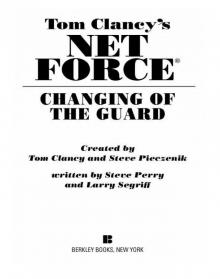 Changing of the Guard
Changing of the Guard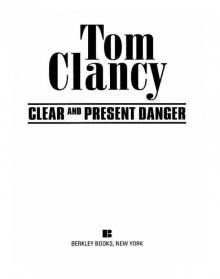 Clear and Present Danger
Clear and Present Danger Hounds of Rome
Hounds of Rome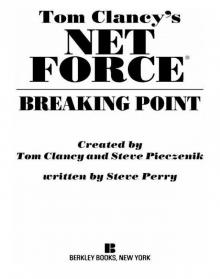 Breaking Point
Breaking Point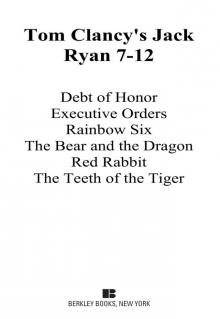 Tom Clancy's Jack Ryan Books 7-12
Tom Clancy's Jack Ryan Books 7-12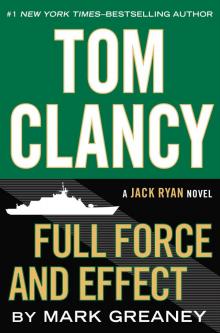 Full Force and Effect
Full Force and Effect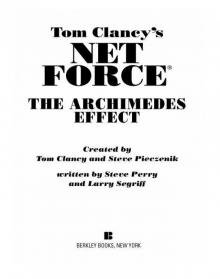 The Archimedes Effect
The Archimedes Effect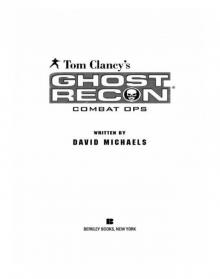 Combat Ops
Combat Ops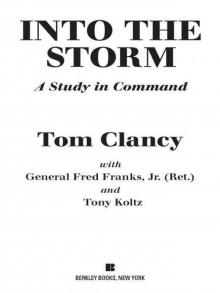 Into the Storm: On the Ground in Iraq
Into the Storm: On the Ground in Iraq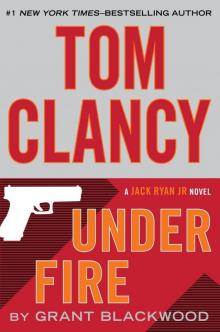 Under Fire
Under Fire Point of Impact
Point of Impact Red Rabbit
Red Rabbit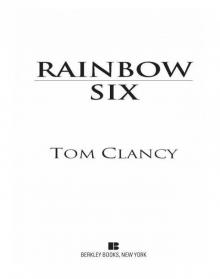 Rainbow Six
Rainbow Six The Hunt for Red October
The Hunt for Red October The Teeth of the Tiger
The Teeth of the Tiger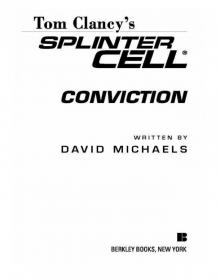 Conviction (2009)
Conviction (2009)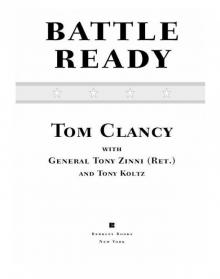 Battle Ready
Battle Ready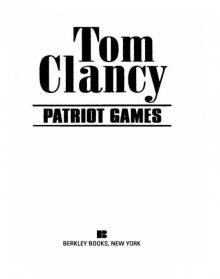 Patriot Games
Patriot Games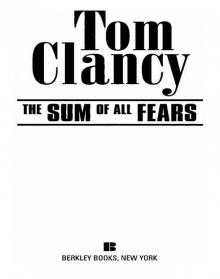 The Sum of All Fears
The Sum of All Fears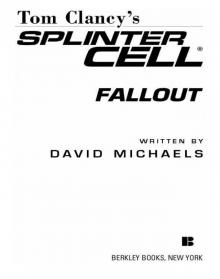 Fallout (2007)
Fallout (2007) Red Storm Rising
Red Storm Rising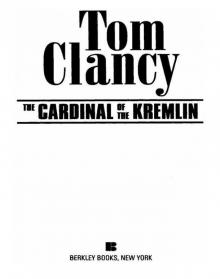 The Cardinal of the Kremlin
The Cardinal of the Kremlin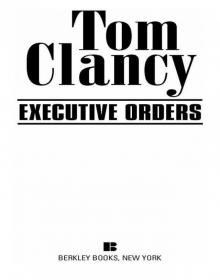 Executive Orders
Executive Orders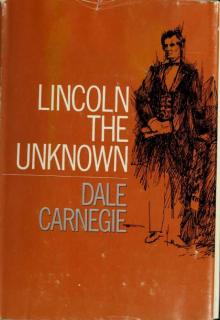 Lincoln, the unknown
Lincoln, the unknown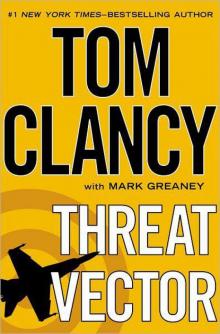 Threat Vector
Threat Vector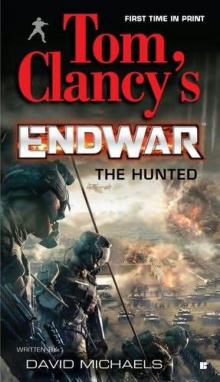 The Hunted
The Hunted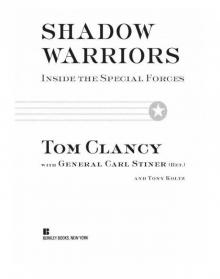 Shadow Warriors: Inside the Special Forces
Shadow Warriors: Inside the Special Forces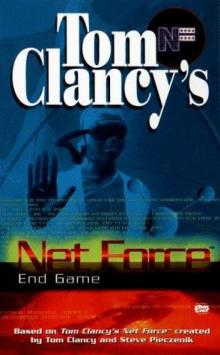 End Game
End Game Special Forces: A Guided Tour of U.S. Army Special Forces
Special Forces: A Guided Tour of U.S. Army Special Forces Locked On
Locked On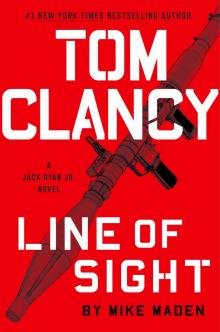 Line of Sight
Line of Sight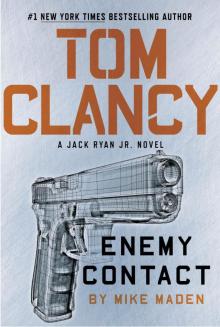 Tom Clancy Enemy Contact - Mike Maden
Tom Clancy Enemy Contact - Mike Maden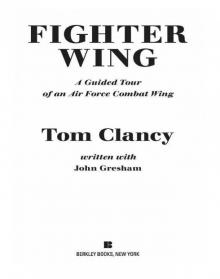 Fighter Wing: A Guided Tour of an Air Force Combat Wing
Fighter Wing: A Guided Tour of an Air Force Combat Wing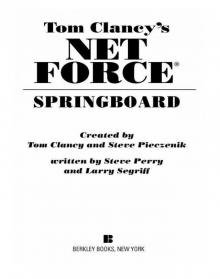 Springboard
Springboard Line of Sight - Mike Maden
Line of Sight - Mike Maden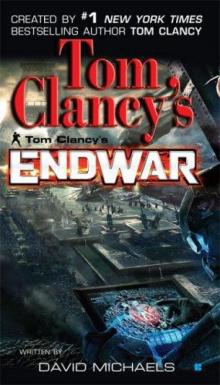 EndWar
EndWar Dead or Alive
Dead or Alive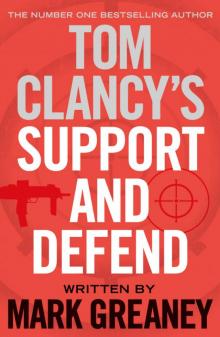 Tom Clancy Support and Defend
Tom Clancy Support and Defend Checkmate
Checkmate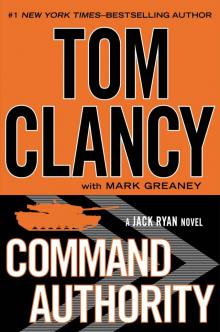 Command Authority
Command Authority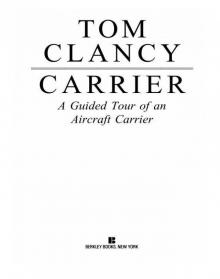 Carrier: A Guided Tour of an Aircraft Carrier
Carrier: A Guided Tour of an Aircraft Carrier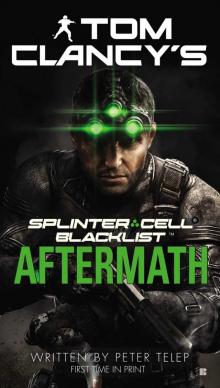 Blacklist Aftermath
Blacklist Aftermath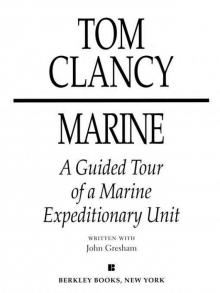 Marine: A Guided Tour of a Marine Expeditionary Unit
Marine: A Guided Tour of a Marine Expeditionary Unit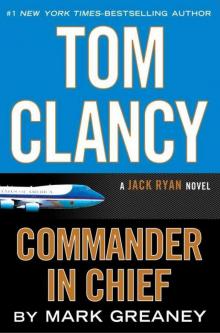 Commander-In-Chief
Commander-In-Chief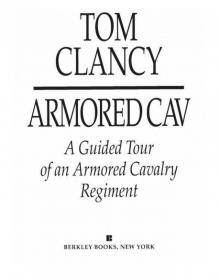 Armored Cav: A Guided Tour of an Armored Cavalry Regiment
Armored Cav: A Guided Tour of an Armored Cavalry Regiment Tom Clancy's Jack Ryan Books 1-6
Tom Clancy's Jack Ryan Books 1-6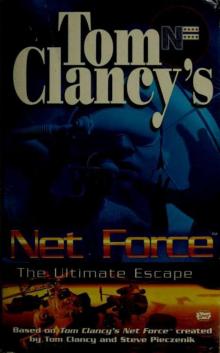 The Ultimate Escape
The Ultimate Escape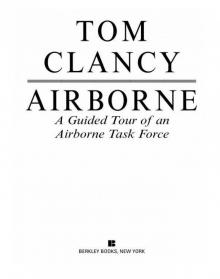 Airborne: A Guided Tour of an Airborne Task Force
Airborne: A Guided Tour of an Airborne Task Force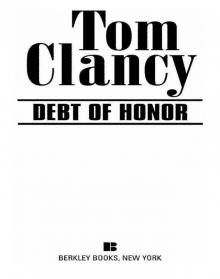 Debt of Honor
Debt of Honor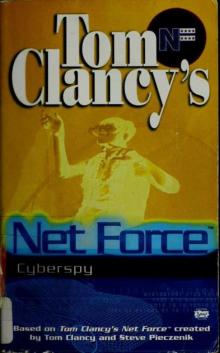 Cyberspy
Cyberspy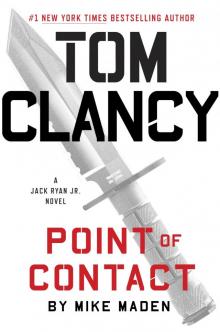 Point of Contact
Point of Contact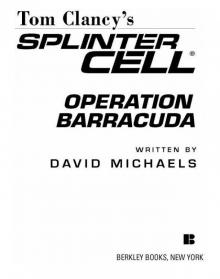 Operation Barracuda (2005)
Operation Barracuda (2005)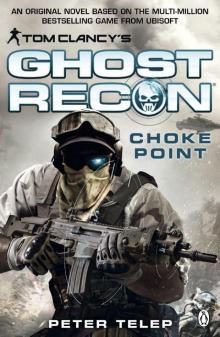 Choke Point
Choke Point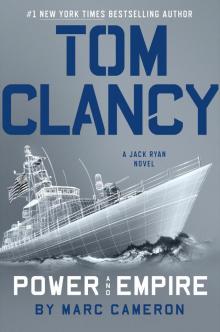 Power and Empire
Power and Empire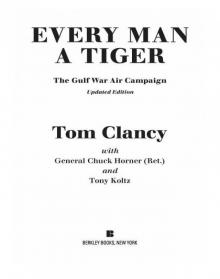 Every Man a Tiger: The Gulf War Air Campaign
Every Man a Tiger: The Gulf War Air Campaign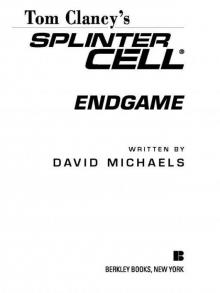 Endgame (1998)
Endgame (1998)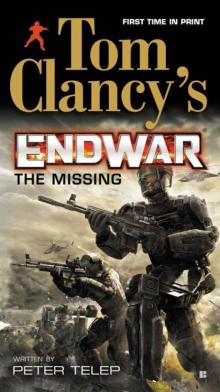 EndWar: The Missing
EndWar: The Missing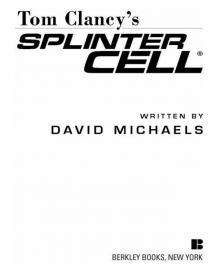 Splinter Cell (2004)
Splinter Cell (2004)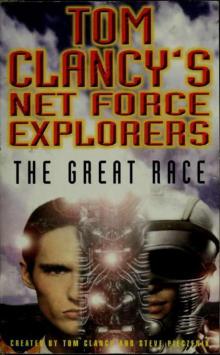 The Great Race
The Great Race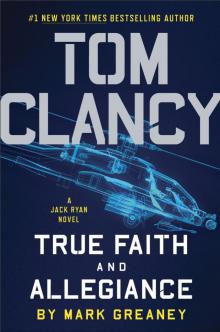 True Faith and Allegiance
True Faith and Allegiance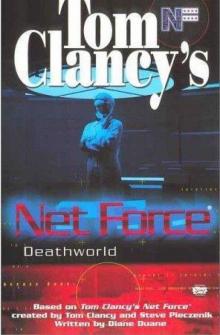 Deathworld
Deathworld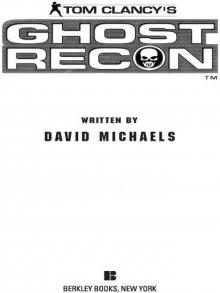 Ghost Recon (2008)
Ghost Recon (2008)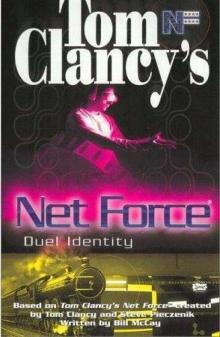 Duel Identity
Duel Identity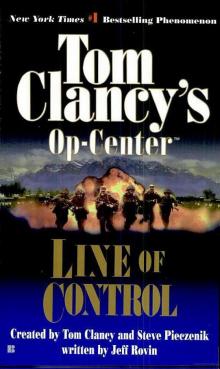 Line of Control o-8
Line of Control o-8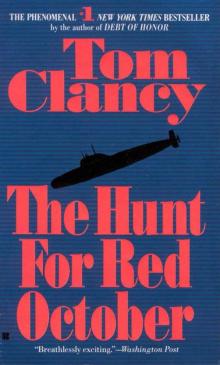 The Hunt for Red October jr-3
The Hunt for Red October jr-3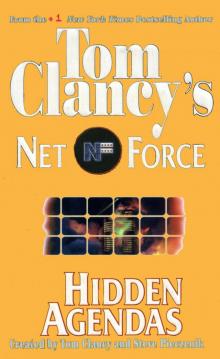 Hidden Agendas nf-2
Hidden Agendas nf-2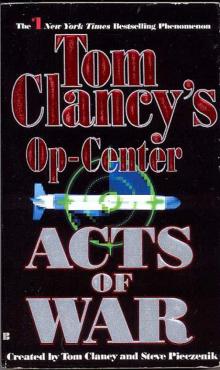 Acts of War oc-4
Acts of War oc-4 Ruthless.Com pp-2
Ruthless.Com pp-2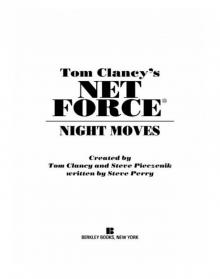 Night Moves
Night Moves The Hounds of Rome - Mystery of a Fugitive Priest
The Hounds of Rome - Mystery of a Fugitive Priest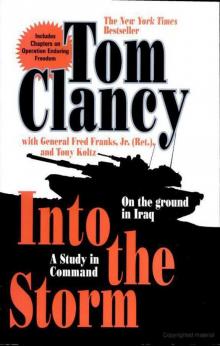 Into the Storm: On the Ground in Iraq sic-1
Into the Storm: On the Ground in Iraq sic-1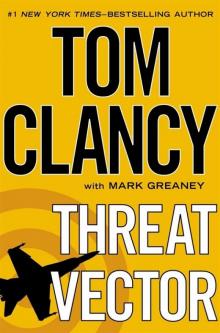 Threat Vector jrj-4
Threat Vector jrj-4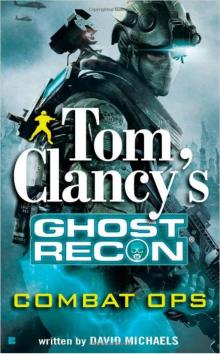 Combat Ops gr-2
Combat Ops gr-2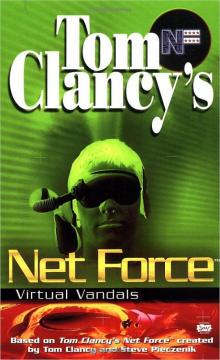 Virtual Vandals nfe-1
Virtual Vandals nfe-1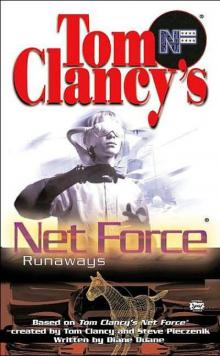 Runaways nfe-16
Runaways nfe-16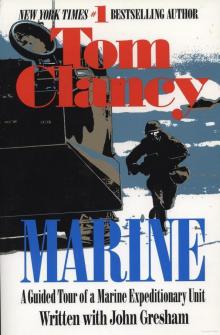 Marine: A Guided Tour of a Marine Expeditionary Unit tcml-4
Marine: A Guided Tour of a Marine Expeditionary Unit tcml-4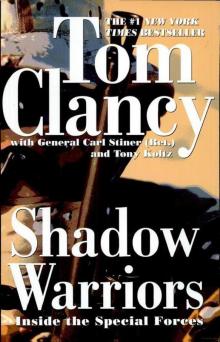 Shadow Warriors: Inside the Special Forces sic-3
Shadow Warriors: Inside the Special Forces sic-3 Jack Ryan Books 1-6
Jack Ryan Books 1-6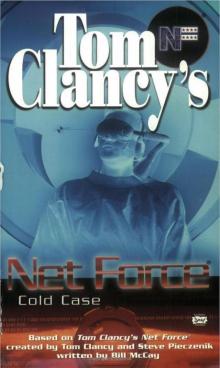 Cold Case nfe-15
Cold Case nfe-15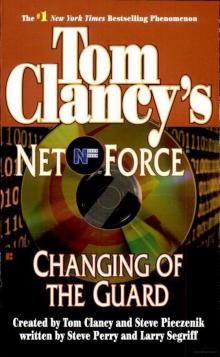 Changing of the Guard nf-8
Changing of the Guard nf-8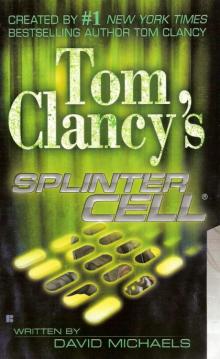 Splinter Cell sc-1
Splinter Cell sc-1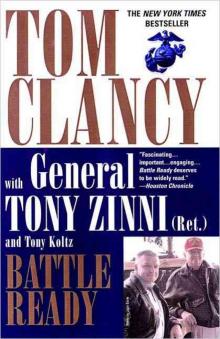 Battle Ready sic-4
Battle Ready sic-4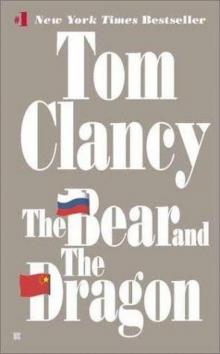 The Bear and the Dragon jrao-11
The Bear and the Dragon jrao-11 Fighter Wing: A Guided Tour of an Air Force Combat Wing tcml-3
Fighter Wing: A Guided Tour of an Air Force Combat Wing tcml-3 Patriot Games jr-1
Patriot Games jr-1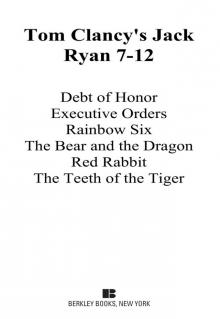 Jack Ryan Books 7-12
Jack Ryan Books 7-12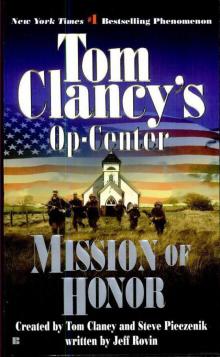 Mission of Honor o-9
Mission of Honor o-9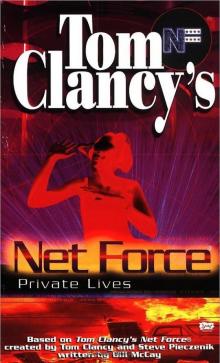 Private Lives nfe-9
Private Lives nfe-9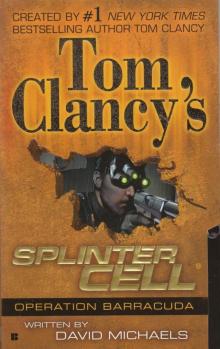 Operation Barracuda sc-2
Operation Barracuda sc-2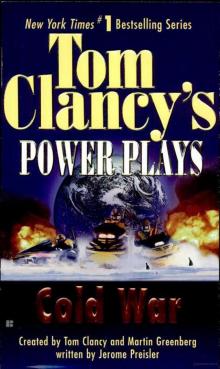 Cold War pp-5
Cold War pp-5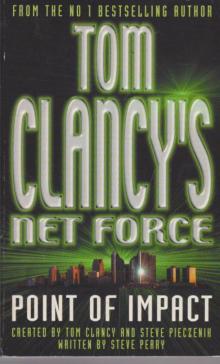 Point of Impact nf-5
Point of Impact nf-5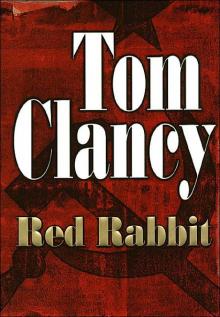 Red Rabbit jr-9
Red Rabbit jr-9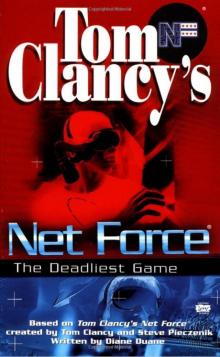 The Deadliest Game nfe-2
The Deadliest Game nfe-2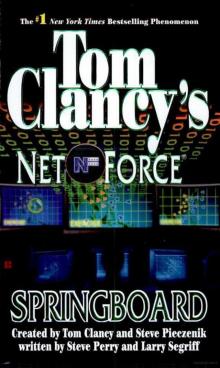 Springboard nf-9
Springboard nf-9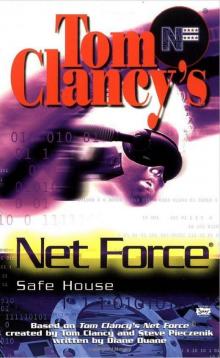 Safe House nfe-10
Safe House nfe-10 EndWar e-1
EndWar e-1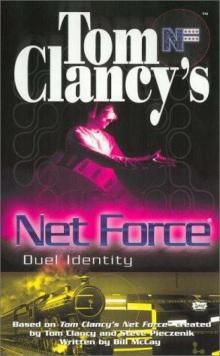 Duel Identity nfe-12
Duel Identity nfe-12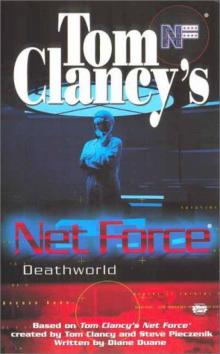 Deathworld nfe-13
Deathworld nfe-13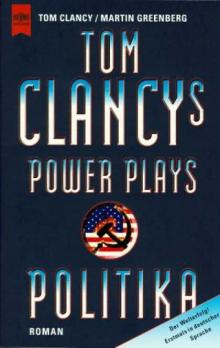 Politika pp-1
Politika pp-1 Rainbow Six jr-9
Rainbow Six jr-9 Tom Clancy's Power Plays 1 - 4
Tom Clancy's Power Plays 1 - 4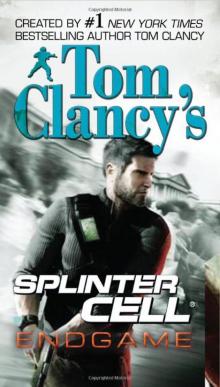 Endgame sc-6
Endgame sc-6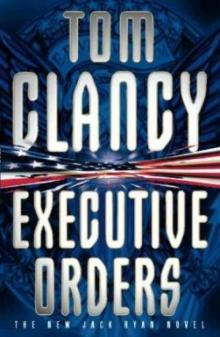 Executive Orders jr-7
Executive Orders jr-7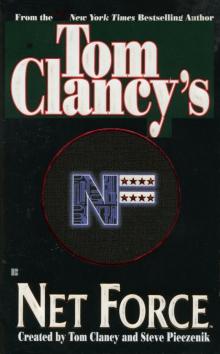 Net Force nf-1
Net Force nf-1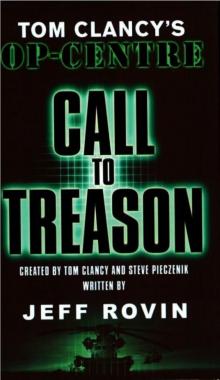 Call to Treason o-11
Call to Treason o-11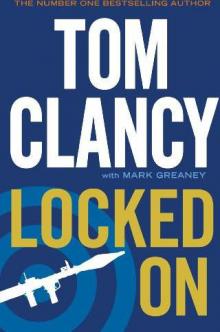 Locked On jrj-3
Locked On jrj-3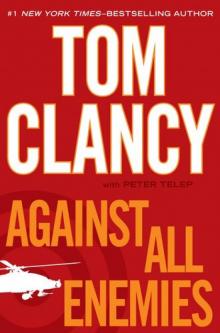 Against All Enemies
Against All Enemies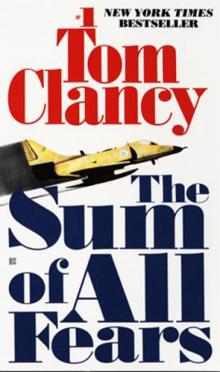 The Sum of All Fears jr-7
The Sum of All Fears jr-7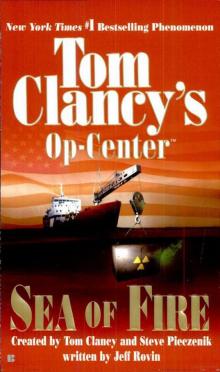 Sea of Fire o-10
Sea of Fire o-10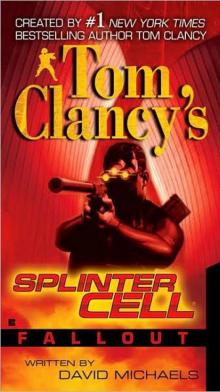 Fallout sc-4
Fallout sc-4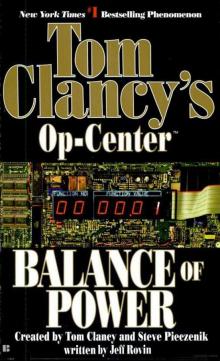 Balance of Power o-5
Balance of Power o-5 Shadow Watch pp-3
Shadow Watch pp-3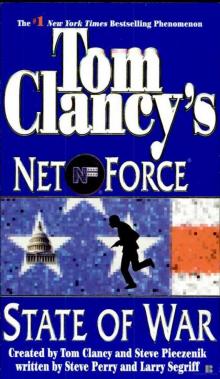 State of War nf-7
State of War nf-7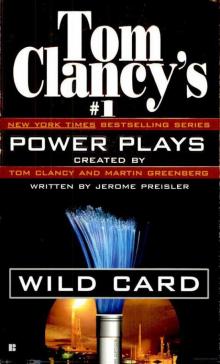 Wild Card pp-8
Wild Card pp-8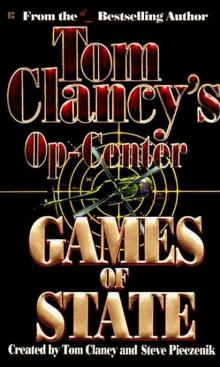 Games of State o-3
Games of State o-3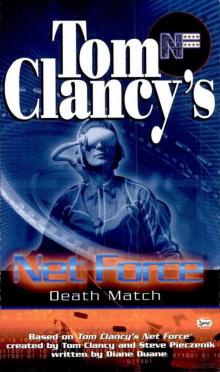 Death Match nfe-18
Death Match nfe-18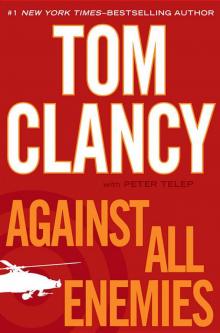 Against All Enemies mm-1
Against All Enemies mm-1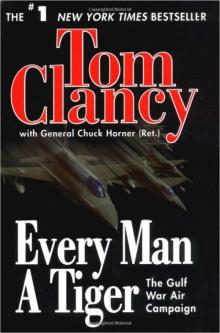 Every Man a Tiger: The Gulf War Air Campaign sic-2
Every Man a Tiger: The Gulf War Air Campaign sic-2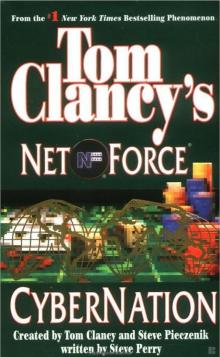 Cybernation nf-6
Cybernation nf-6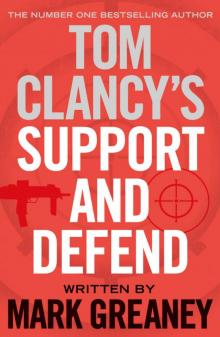 Support and Defend
Support and Defend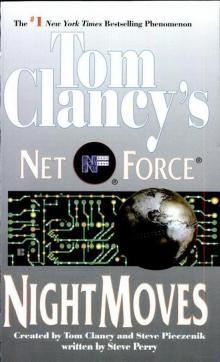 Night Moves nf-3
Night Moves nf-3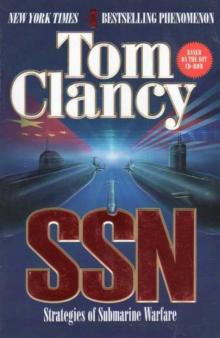 SSN
SSN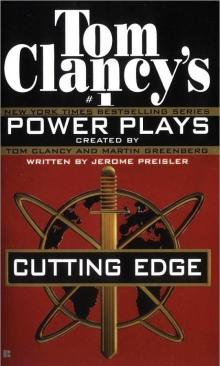 Cutting Edge pp-6
Cutting Edge pp-6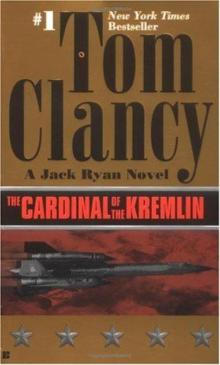 The Cardinal of the Kremlin jrao-5
The Cardinal of the Kremlin jrao-5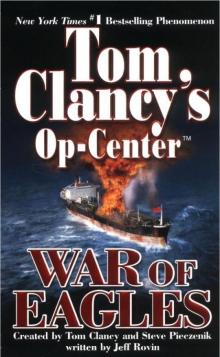 War of Eagles o-12
War of Eagles o-12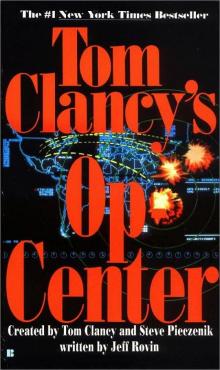 Op-Center o-1
Op-Center o-1 Mirror Image o-2
Mirror Image o-2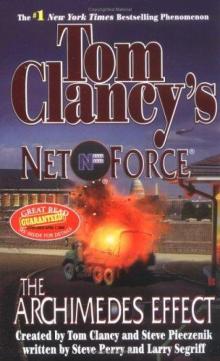 The Archimedes Effect nf-10
The Archimedes Effect nf-10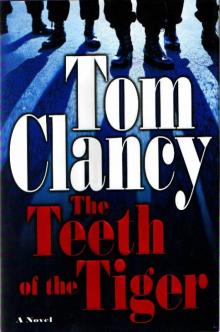 Teeth of the Tiger jrj-1
Teeth of the Tiger jrj-1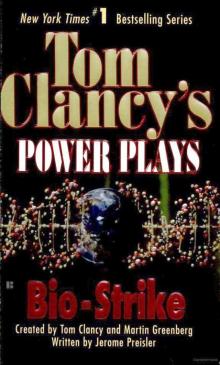 Bio-Strike pp-4
Bio-Strike pp-4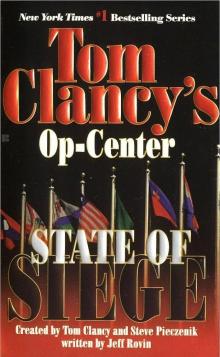 State of Siege o-6
State of Siege o-6 Debt of Honor jr-6
Debt of Honor jr-6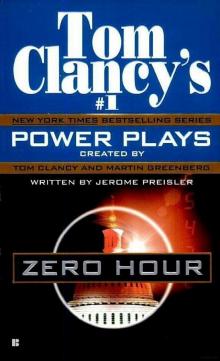 Zero Hour pp-7
Zero Hour pp-7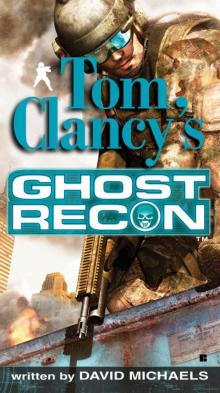 Ghost Recon gr-1
Ghost Recon gr-1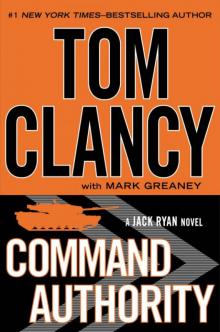 Command Authority jr-10
Command Authority jr-10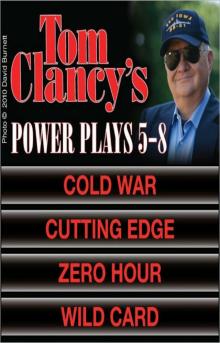 Tom Clancy's Power Plays 5 - 8
Tom Clancy's Power Plays 5 - 8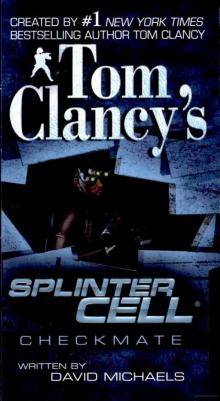 Checkmate sc-3
Checkmate sc-3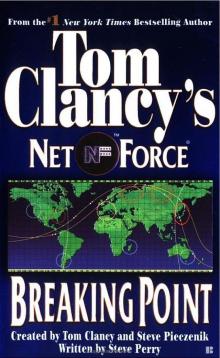 Breaking Point nf-4
Breaking Point nf-4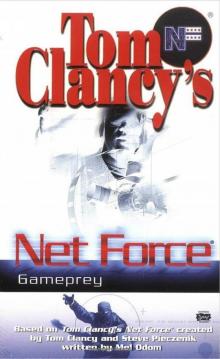 Gameprey nfe-11
Gameprey nfe-11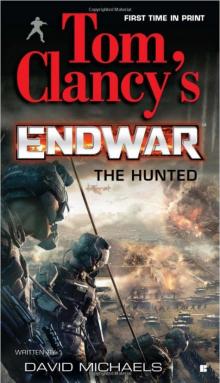 The Hunted e-2
The Hunted e-2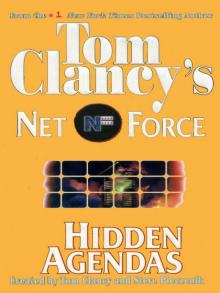 Hidden Agendas
Hidden Agendas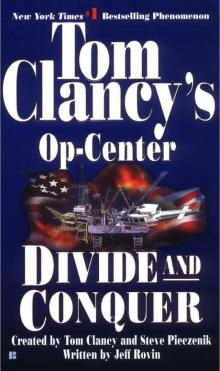 Divide and Conquer o-7
Divide and Conquer o-7